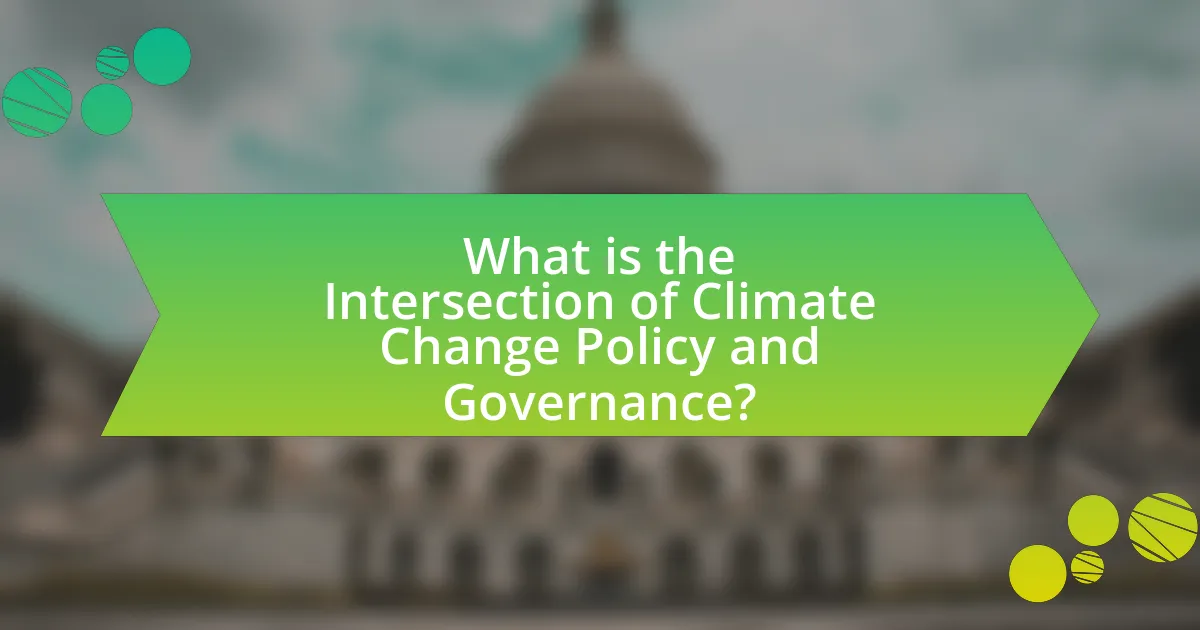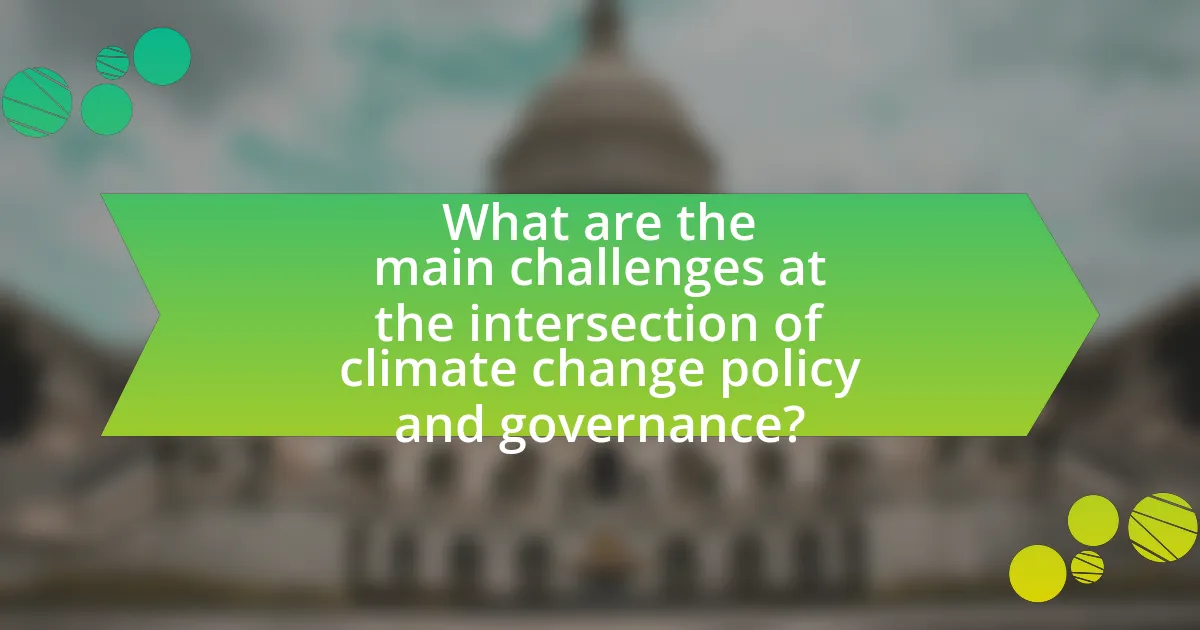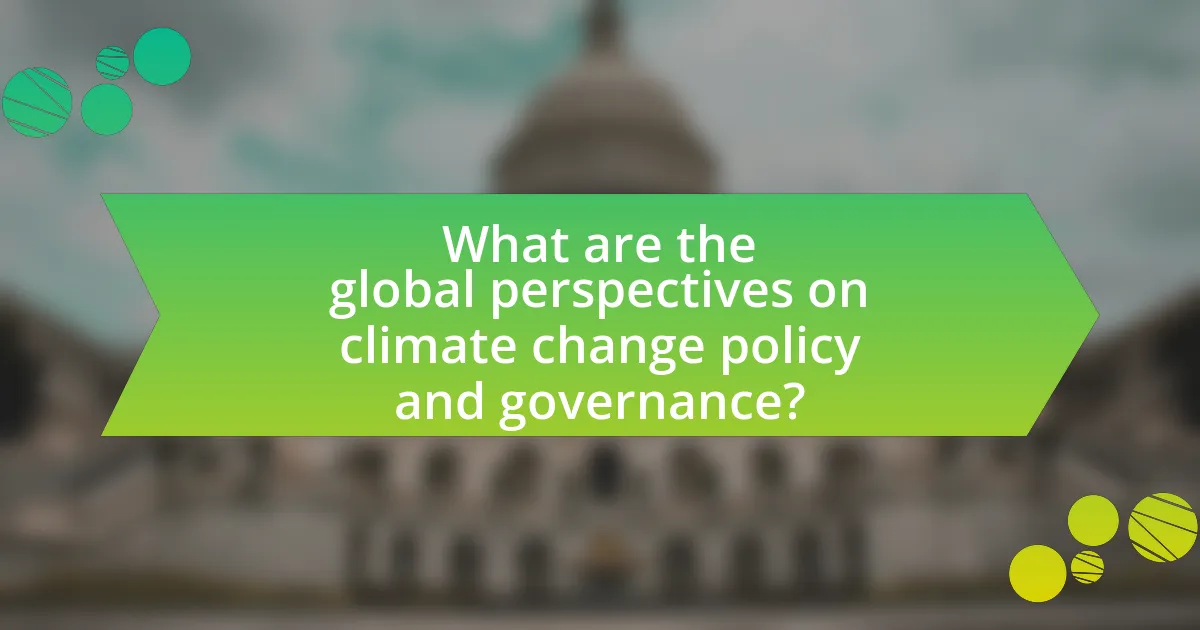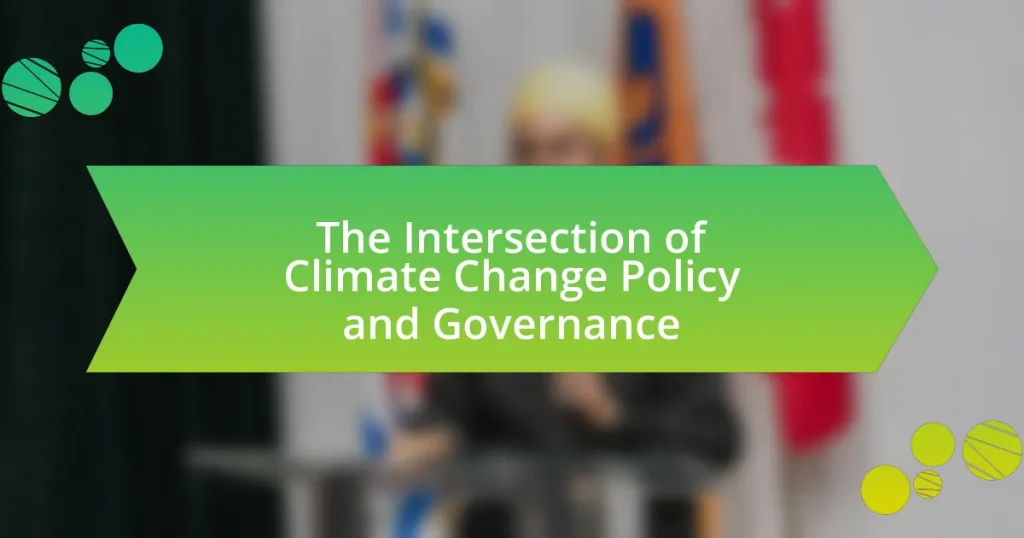The article examines the intersection of climate change policy and governance, highlighting how governmental structures influence the formulation and effectiveness of climate initiatives. It discusses the critical role of effective governance in implementing regulations that mitigate greenhouse gas emissions and promote renewable energy, as exemplified by the Paris Agreement. Key components of climate policies, such as mitigation strategies and regulatory frameworks, are outlined, along with the challenges policymakers face, including political resistance and economic constraints. The article emphasizes the importance of stakeholder engagement and international cooperation in enhancing climate governance and achieving sustainable outcomes.

What is the Intersection of Climate Change Policy and Governance?
The intersection of climate change policy and governance refers to the ways in which governmental structures and processes shape the formulation, implementation, and effectiveness of policies aimed at addressing climate change. Effective governance is essential for creating and enforcing regulations that mitigate greenhouse gas emissions, promote renewable energy, and enhance climate resilience. For instance, the Paris Agreement, adopted in 2015, exemplifies how international governance frameworks can drive national policies towards climate action by setting binding targets and encouraging cooperation among countries. This intersection is critical as it determines the allocation of resources, stakeholder engagement, and the overall success of climate initiatives, ultimately influencing global efforts to combat climate change.
How do climate change policies influence governance structures?
Climate change policies significantly influence governance structures by necessitating the integration of environmental considerations into decision-making processes. These policies often lead to the establishment of new regulatory frameworks, such as emissions trading systems and renewable energy mandates, which require governments to adapt their administrative capacities and inter-agency coordination. For instance, the implementation of the Paris Agreement has prompted countries to develop national climate action plans, thereby reshaping governance at both local and national levels to prioritize sustainability and accountability. This shift is evidenced by the increased collaboration between governmental bodies and non-state actors, such as NGOs and private sectors, to achieve climate goals, demonstrating a more inclusive governance model that reflects the urgency of climate action.
What are the key components of climate change policies?
The key components of climate change policies include mitigation strategies, adaptation measures, regulatory frameworks, and financial mechanisms. Mitigation strategies focus on reducing greenhouse gas emissions through renewable energy adoption, energy efficiency improvements, and carbon pricing. Adaptation measures aim to enhance resilience against climate impacts, such as infrastructure improvements and disaster preparedness plans. Regulatory frameworks establish legal standards and guidelines for emissions reductions and environmental protection. Financial mechanisms, including funding and investment in sustainable technologies, support the implementation of these policies. These components are essential for effective climate governance and achieving international climate agreements, such as the Paris Agreement, which aims to limit global warming to well below 2 degrees Celsius.
How do governance frameworks adapt to climate change policies?
Governance frameworks adapt to climate change policies by integrating sustainability principles into decision-making processes and enhancing stakeholder engagement. These frameworks evolve to incorporate climate risk assessments, ensuring that policies reflect the urgency of climate action. For instance, the Paris Agreement has prompted countries to revise their national governance structures to align with international climate commitments, leading to the establishment of climate action plans and regulatory measures that prioritize emissions reductions. Additionally, frameworks increasingly utilize data-driven approaches, such as climate modeling and impact assessments, to inform policy adjustments and resource allocation, thereby reinforcing their effectiveness in addressing climate challenges.
Why is the intersection of climate change policy and governance important?
The intersection of climate change policy and governance is important because it ensures effective implementation and enforcement of climate initiatives. Effective governance structures facilitate the integration of scientific research into policy-making, enabling governments to create informed strategies that address climate change impacts. For instance, countries that have established clear governance frameworks, such as the European Union’s Green Deal, demonstrate enhanced coordination among member states, leading to more ambitious climate targets and collective action. This alignment between policy and governance is crucial for mobilizing resources, engaging stakeholders, and achieving international climate agreements like the Paris Accord, which aims to limit global warming to well below 2 degrees Celsius.
What are the potential impacts on society and the environment?
The potential impacts on society and the environment due to climate change policy and governance include increased social inequality and environmental degradation. Climate change policies can lead to economic shifts that disproportionately affect low-income communities, as seen in studies indicating that carbon pricing can raise energy costs, impacting vulnerable populations more severely. Additionally, ineffective governance can result in inadequate environmental protections, leading to biodiversity loss and increased pollution levels, which have been documented in reports from organizations like the Intergovernmental Panel on Climate Change. These impacts highlight the critical need for equitable and effective climate governance to mitigate adverse effects on both society and the environment.
How does effective governance enhance climate change policy outcomes?
Effective governance enhances climate change policy outcomes by ensuring accountability, transparency, and stakeholder engagement in decision-making processes. When governance structures are robust, they facilitate the implementation of policies that are scientifically informed and socially equitable. For instance, countries with strong governance frameworks, such as those adhering to the principles of the Paris Agreement, have shown improved emissions reduction targets and better adaptation strategies. Research indicates that nations with effective governance mechanisms are more likely to mobilize resources and foster public-private partnerships, which are crucial for funding climate initiatives. This correlation is evident in the Global Climate Governance Index, which ranks countries based on their governance quality and climate action effectiveness, demonstrating that higher governance scores align with better climate policy outcomes.

What are the main challenges at the intersection of climate change policy and governance?
The main challenges at the intersection of climate change policy and governance include coordination among multiple stakeholders, the integration of scientific data into policy-making, and the enforcement of regulations. Coordination is difficult due to the involvement of various levels of government, private sectors, and international bodies, which can lead to conflicting interests and priorities. The integration of scientific data is often hampered by gaps in knowledge and the complexity of climate models, making it challenging for policymakers to make informed decisions. Enforcement of regulations is complicated by limited resources, political resistance, and the need for public support, which can undermine the effectiveness of climate policies. These challenges are evidenced by the slow progress in achieving international climate agreements, such as the Paris Agreement, where countries struggle to meet their commitments due to these governance issues.
What obstacles do policymakers face in implementing climate change governance?
Policymakers face significant obstacles in implementing climate change governance, primarily due to political resistance, economic constraints, and lack of public support. Political resistance often stems from differing ideologies and interests among stakeholders, which can lead to gridlock in decision-making processes. Economic constraints include limited financial resources and competing budget priorities, making it challenging to allocate funds for climate initiatives. Additionally, lack of public support can hinder the adoption of necessary policies, as citizens may prioritize immediate economic concerns over long-term environmental goals. These factors collectively impede effective governance and the implementation of comprehensive climate change strategies.
How do political interests affect climate change policy decisions?
Political interests significantly influence climate change policy decisions by shaping the priorities and actions of lawmakers. For instance, politicians often align climate policies with the interests of their constituents, industries, or donors, which can lead to the prioritization of economic growth over environmental protection. A study by the Yale Program on Climate Change Communication found that political affiliation strongly correlates with public concern about climate change, affecting legislative action. Additionally, lobbying by fossil fuel companies has historically resulted in weakened regulations and delayed climate initiatives, as seen in the United States, where the oil and gas sector spent over $200 million on lobbying in 2020 alone. This demonstrates that political interests can create barriers to effective climate action, ultimately impacting the effectiveness and urgency of climate change policies.
What role does public opinion play in shaping climate governance?
Public opinion significantly influences climate governance by shaping policy priorities and driving political action. When a substantial portion of the public expresses concern about climate change, it compels policymakers to prioritize environmental issues, as seen in the rise of climate-focused legislation in response to public demand for action. For instance, surveys indicate that over 70% of Americans support government action on climate change, which has led to increased funding for renewable energy initiatives and stricter emissions regulations. This correlation between public sentiment and policy development underscores the critical role that collective attitudes play in determining the direction and effectiveness of climate governance.
How can governance frameworks be improved to address climate change?
Governance frameworks can be improved to address climate change by integrating adaptive management practices that allow for flexibility and responsiveness to new scientific data. This approach enables policymakers to adjust regulations and strategies based on the latest climate research, ensuring that governance remains effective in the face of evolving challenges. For instance, the Intergovernmental Panel on Climate Change (IPCC) emphasizes the need for iterative policy processes that incorporate stakeholder feedback and scientific advancements, which can enhance the resilience of governance structures. Additionally, establishing clear accountability mechanisms and performance metrics can drive transparency and effectiveness in climate governance, as evidenced by successful initiatives in countries like Sweden, which has implemented a carbon tax that has significantly reduced emissions while promoting economic growth.
What best practices exist for integrating climate change into governance?
Best practices for integrating climate change into governance include establishing clear policies, engaging stakeholders, and implementing adaptive management strategies. Clear policies provide a framework for action, such as the Paris Agreement, which sets international climate targets. Engaging stakeholders, including local communities and businesses, ensures diverse perspectives and fosters collaboration, as seen in participatory governance models. Adaptive management strategies allow for flexibility and responsiveness to changing climate conditions, exemplified by the use of climate action plans that are regularly updated based on new data and outcomes. These practices enhance resilience and effectiveness in addressing climate change within governance structures.
How can stakeholder engagement enhance policy effectiveness?
Stakeholder engagement enhances policy effectiveness by fostering collaboration, ensuring diverse perspectives are considered, and increasing accountability. Engaging stakeholders, such as community members, businesses, and experts, allows policymakers to gather valuable insights that can lead to more informed decisions. For instance, research by the World Resources Institute indicates that inclusive stakeholder processes can improve the legitimacy and acceptance of climate policies, leading to higher compliance rates and better outcomes. This collaborative approach not only addresses the needs and concerns of various groups but also builds trust, which is essential for the successful implementation of policies aimed at mitigating climate change.

What are the global perspectives on climate change policy and governance?
Global perspectives on climate change policy and governance emphasize the need for collaborative international efforts, recognizing that climate change is a transboundary issue requiring coordinated responses. Various countries adopt differing approaches based on their economic capabilities, historical emissions, and vulnerability to climate impacts. For instance, developed nations often advocate for stringent emissions reductions and financial support for developing countries, while developing nations may prioritize economic growth and adaptation strategies. The Paris Agreement exemplifies a global framework where nations commit to limit temperature rise, reflecting a consensus on the urgency of climate action. Additionally, reports from the Intergovernmental Panel on Climate Change (IPCC) highlight the importance of integrating climate policies into national governance structures to enhance resilience and sustainability.
How do different countries approach climate change governance?
Different countries approach climate change governance through a variety of frameworks and policies tailored to their specific economic, social, and environmental contexts. For instance, the European Union emphasizes collective action and legally binding targets through mechanisms like the European Green Deal, aiming for carbon neutrality by 2050. In contrast, the United States has fluctuated between federal and state-level initiatives, with recent efforts focusing on rejoining international agreements like the Paris Accord and implementing regulations to reduce emissions. Additionally, countries like China prioritize state-led initiatives, investing heavily in renewable energy and setting ambitious targets for carbon peak and neutrality by 2060. These diverse approaches reflect the unique challenges and priorities each nation faces in addressing climate change, supported by their respective commitments to international agreements and domestic policies.
What lessons can be learned from successful international policies?
Successful international policies demonstrate the importance of collaboration and shared responsibility among nations in addressing global challenges. For instance, the Paris Agreement, adopted in 2015, exemplifies how countries can unite to set collective climate goals, leading to a significant reduction in greenhouse gas emissions. This agreement has seen participation from 196 countries, highlighting the effectiveness of a multilateral approach in fostering accountability and commitment. Additionally, successful policies often incorporate scientific research and data-driven decision-making, as seen in the Intergovernmental Panel on Climate Change (IPCC) reports, which provide critical assessments that guide policy frameworks. These examples illustrate that effective international policies rely on cooperation, evidence-based strategies, and a commitment to shared objectives.
How do cultural differences influence climate governance strategies?
Cultural differences significantly influence climate governance strategies by shaping values, priorities, and approaches to environmental issues. For instance, collectivist cultures may prioritize community-based solutions and emphasize social equity in climate policies, while individualistic cultures might focus on market-driven approaches and personal responsibility. Research indicates that countries with strong environmental ethics, often rooted in cultural beliefs, tend to adopt more stringent climate regulations. For example, Scandinavian nations, influenced by a cultural emphasis on sustainability, have implemented comprehensive climate action plans that reflect their societal values. This cultural context directly affects how policies are formulated, implemented, and accepted by the public, ultimately determining the effectiveness of climate governance strategies.
What role do international organizations play in climate change governance?
International organizations play a crucial role in climate change governance by facilitating international cooperation, setting regulatory frameworks, and providing financial and technical support to countries. These organizations, such as the United Nations Framework Convention on Climate Change (UNFCCC), establish agreements like the Paris Agreement, which aims to limit global warming to well below 2 degrees Celsius. They also monitor compliance and progress through mechanisms like the Global Stocktake, which assesses collective efforts every five years. Furthermore, international organizations mobilize funding through initiatives like the Green Climate Fund, which supports developing countries in their climate adaptation and mitigation efforts. This multifaceted approach underscores their importance in coordinating global responses to climate change challenges.
How do treaties and agreements shape national policies?
Treaties and agreements shape national policies by establishing binding commitments that countries must adhere to, influencing domestic legislation and regulatory frameworks. For instance, the Paris Agreement requires signatory nations to set and achieve specific greenhouse gas emission reduction targets, compelling them to implement policies that align with these international obligations. This has led to the adoption of renewable energy initiatives and emissions trading systems in various countries, demonstrating how international agreements directly impact national policy decisions.
What is the impact of global cooperation on local governance?
Global cooperation significantly enhances local governance by providing frameworks, resources, and best practices that empower local authorities to address climate change effectively. For instance, international agreements like the Paris Agreement facilitate knowledge sharing and funding opportunities, enabling local governments to implement sustainable policies. Research by the United Nations Development Programme highlights that cities engaged in global networks are more likely to adopt innovative climate solutions, demonstrating that collaboration on a global scale directly influences local governance capabilities and outcomes.
What practical steps can be taken to enhance climate change governance?
To enhance climate change governance, governments should implement comprehensive policies that integrate climate action into all sectors, ensuring accountability and transparency. This can be achieved by establishing legally binding emissions reduction targets, as seen in the European Union’s Climate Law, which mandates a 55% reduction in greenhouse gas emissions by 2030 compared to 1990 levels. Additionally, fostering multi-stakeholder engagement, including local communities, businesses, and NGOs, can improve policy effectiveness and public support. For instance, the Global Covenant of Mayors for Climate and Energy involves over 10,000 cities in climate action, demonstrating the power of local governance. Finally, investing in climate data and research enhances decision-making, as evidenced by the IPCC’s comprehensive assessments that guide national policies.
How can local governments implement effective climate policies?
Local governments can implement effective climate policies by establishing comprehensive sustainability plans that integrate community input and scientific data. These plans should include specific targets for reducing greenhouse gas emissions, promoting renewable energy, and enhancing energy efficiency. For instance, cities like San Francisco have successfully reduced emissions by 36% since 1990 through policies that prioritize public transportation and green building standards. Additionally, local governments can leverage funding from state and federal programs to support climate initiatives, as seen in the case of the California Climate Investments program, which allocates billions to local projects aimed at reducing carbon footprints. Engaging stakeholders, including businesses and residents, in the policy-making process ensures that the measures adopted are practical and widely supported, further enhancing their effectiveness.
What resources are available for policymakers to improve governance?
Policymakers can access various resources to improve governance, including research reports, best practice guidelines, and collaborative platforms. Research reports from organizations like the World Bank and the United Nations provide data-driven insights into effective governance strategies, particularly in the context of climate change. Best practice guidelines, such as those from the OECD, offer frameworks for enhancing transparency, accountability, and stakeholder engagement. Collaborative platforms, like the Global Climate Action Summit, facilitate knowledge sharing among policymakers, enabling them to learn from successful governance models implemented in different regions. These resources collectively support informed decision-making and effective governance in addressing climate change challenges.






